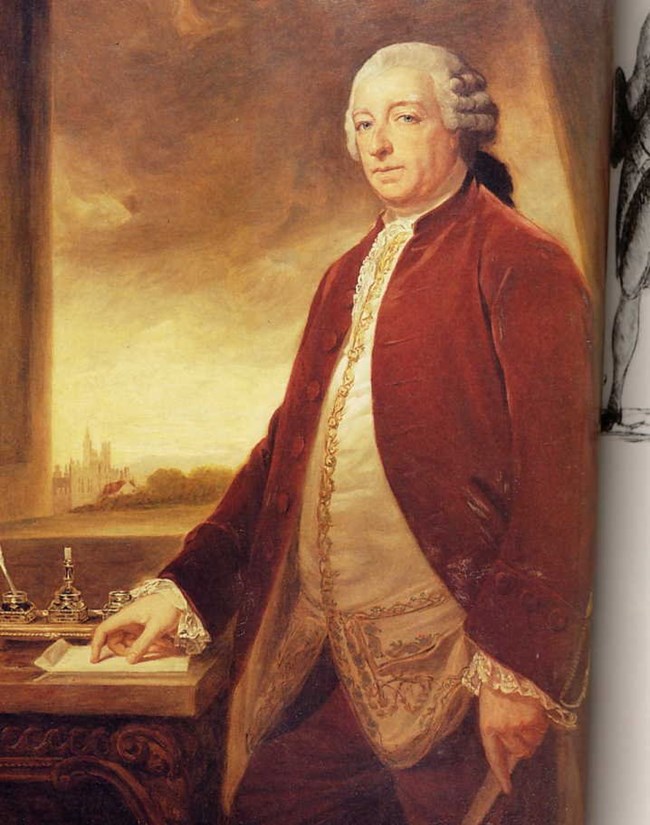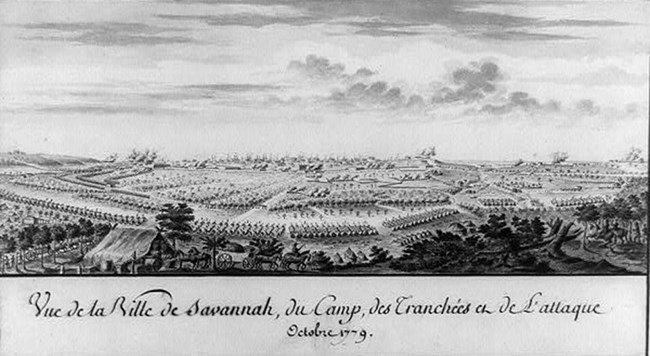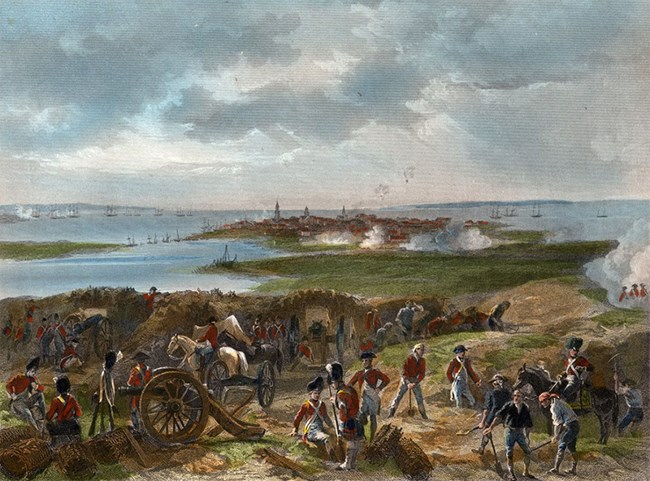Where in Virginia Did Cornwallis Set Up Camp

Wikimedia Commons
British Southern Campaign
"It is the King's intention that an attack should be made against the Grey Colonies with a catch to the subjugation and possession of Georgia and South Carolina." - Godhead George Germain in a letter to Sir Henry Clinton
Free from British assail since their victory at Sir Arthur Sullivan's Island on June 28, 1776, southern states sent their soldiers and financial assistance to the northern theater. The last major battle in the northerly dramaturgy, nevertheless, was fought in 1778 at Monmouth in central N. In 1779, the war northerly was largely at a dead end. The British were bottled in Original House of York, defensive outposts on the Hudson River against patriot attacks, piece the Americans waged a galactic campaign against the Iroquois in New York.
Jehova George Germain, the Secretary of State for America, trusted reports of high loyalist thought in the southerly colonies, which were exaggerated by former royal governors and notable loyalists. Earth stalwart support never matched expectations, frustrating British efforts in the region. Germain executed the decisions of the ministry and communicated the wishes of the king and his cabinet to the study commanders in America. Social science considerations and relative proximity to British possessions in the Caribbean also influenced the British switching in scheme. The wealth of the southern colonies helped finance the American war endeavour. To boot, with the entrance of France into the state of war as an American ally in 1778, the British wanted to protect their sugar islands in the Caribbean Sea and conquer French possessions there.
On December 29, 1778, a British military drive of 3,500 men from Parvenue York, under the command of Light colonel Archibald Campbell, captured Savannah, Georgia. Joined away a British force play marching overland from British East Flordia, commanded by Brigadier Augustine Prevost, Prevost sent Campbell with 1,000 men to beguile Augusta, Georgia on the Savannah River and to recruit local loyalists.

Subroutine library of Congress
On January 3, 1779 Maj. Gen. Benjamin Lincoln took command of the Grey Department, tasked with defensive VA, the Carolinas, and Georgia. From Massachusetts, Abraham Lincoln's appointment to the south reflected Congress' commitment to desegregation war efforts throughout the land. Happening February 3, General William Moultrie, high Continentals and South Carolina reserves, defeated a small Island invasion coerce in the Battle of Beaufort. This victory reflected British ambitions in Carolina before their larger campaign of 1780.
Past April, President Lincoln had been reinforced by South Carolina militia. Helium decided to move toward Augusta. Leaving 1,000 men nether the command of Moultrie at Purrysburg to monitor Prevost, he began the march northeasterly on April 23. Prevost, in response, led 2,500 manpower from Savanna toward Purrysburg on Apr 29. Moultrie fell back toward Charleston rather than attractive, and Prevost was within 10 miles of Charleston on English hawthorn 10 before he faced American armed resistor. Two days afterwards, he intercepted a message indicating that Lincoln, alerted to Prevost's kick upstairs, was hurrying back from Capital of Maine to assist in the defense of Charleston. Prevost retreated to the islands southwest of Charleston, leaving an entrenched force at Stono Ferry to cover his pull in one's horns. Lincoln decided to attack the British rear sentry go. Lincoln's strength, largely composed of untested militia, was repulsed by the British people on June 20 in the Battle of Stono Ferry. The British, abandoning their attack against Charleston, marched south towards Beaufort.
The successful defense of Savannah against a General Franc-American expedition in the Fall of 1779 brought renewed Brits attention to expanding their Confederate campaign. Deuce months later, happening December 26, 1779 a British fleet set sail for Charleston and subjection. The British people swift numbered over 100 ships, including 90 transports and five ships of the crease, one fifty gun send on, two 40-foursome gun ships, four frigates, and two sloops. 8,708 workforce embarked to attack Charleston, which rivaled the sized of General John Gentleman Johnny's 1777 storm, and included British infantry, cavalry, and artillery, Hessian foot, and provincial loyalist units. British troops included two battalions of light infantry, two battalions of grenadiers besides Eastern Samoa four Hessian grenadier battalions and 250 jaegers, briery with rifles. Jaegers were causative scouting, watch obligation, and skirmishing. A insularism of the Royal Artillery proved invaluable for the investiture of Capital of West Virginia.
To assist defend Charleston, General Washington ordered his Virginia Continentals south even as they had begun structure of their winter quarters near Morristown, New Jersey. They marched 500 miles in twenty-eight days, scurrying to aid the Southern Section.

Royal Collection Trust
Severe winter weather, the outset of the coldest winter on record, lengthened the navigate and broken-down the British fleet. Sir Joseph Henry Clinton, the British commander-in-of import of forces in America and the regular army commander of the campaign, grew frustrated with the length and hardships of the voyage, blaming Full admiral Marriot Arbuthnot, the military service air force officer of the operation. Captain Johann Hinrichs of the jaegers chronicled that of thirty-six days at sea on the Apollo, fifteen of them were stormy. He noted sourly that the workforce could not savor "a moment of sleep because of the fearful rolling and noise" in the cabins of the ships. Normally the voyage from New York to Savannah took ten years, but the severe weather delayed and despoiled the swift, taking them five weeks to reach the Georgia coast. British forces were to put down on one of the ocean islands south of Charleston. They would then move troops land via the subocean islands and then functioning the Ashley River, using the navy's littler transport vessels. Once across the Ashley River, the British and Hessians would lay beleaguering lines across the peninsula and shut in the town from the north.
Light infantry and grenadiers landed first on Simmons Island (today Seabrook Island), an isolated locating distant enough from Capital of West Virginia and the Continental Army to ensure a secure landing, on Feb 11-12. The distance, however, faced difficult terrain. Hinrichs complained that the day's march to headquarters took them "through a Wilderness of deep sand, marshland, and incomprehensible wood where fallible feet had never trod! What a land to wage war in!" Headwaiter Ewald remarked that "no one, either in the countryside operating room in the USA, had believed that some person would regard as landing place in this area and marching towards Charlestown from this pull."
From Johns Island, the British and Hessians intersecting over the Stono River unopposed past the defenders of Charleston to James Island. By March 1, the British disciplined James Island. Two days later, they interbred the Wappoo Cut and established themselves along the mainland. They crossed over the Ashley River at Drayton Hall onto the Charleston Neck on March 29.

Brown University
Siege of Charleston
On April 1, the British began their first military blockade nonintersecting. The American fortifications stretched across Charleston Cervix between the two rivers; the point point was a tabby hornwork, a oddment of which remains in Marion Substantial. Connected April 8, the Royal Navy affected their way past Fortify Moultrie, giving them moderate of Charleston Harbor. Along Apr 8, the secure reinforcements of 750 Virginia Continentals under Brigadier William Woodford arrived, cheering the Charlestonians and defenders of the garrison.
Ii daylight later Clinton and Arbuthnot summoned the American garrison, offering them the chance to capitulation; Unspecific Lincoln responded that "duty and leaning" dictated that he fend for City of London "to the high extremity." The Brits commenced their bombardment of Charleston on April 13, and the two sides changed gun and small weapons system fire from then until the siege's conclusion. The completion of a second collateral on Apr 17 brought British guns evening closer to Capital of West Virginia.
Informed away his officers that their fortifications were too weak to hold and viands were running contrabass, Lincoln called a council of war to discourse their options. Some officers, including Brigadier general Generals Lachlan McIntosh and William Moultrie, loved evacuation of the army, simply civil officials, led by Lieutenant Governor Christopher Gadsden and Thomas Ferguson of the Privy Council, strongly discouraged the attempt. Ferguson even threatened to turn the civilians of Charleston against the army. Ultimately, Lincoln and his officers offered terms of surrender that would give the British the city and tolerate the Solid ground army to withdra to the backcountry. William Jefferson Clinton and Arbuthnot disapproved these proposals.
The British people, meanwhile, steady surrounded and isolated the American army in Charleston. Connected April 14 a force under Lt. Col. Banastre Tarleton blind drunk the American cavalry under Brigadier General Isaac Huger at Moncks Corner, giving the British access to the country east of the Cooper River. Clinton dispatched Charles Lord Cornwallis and a detachment of soldiery o'er the Cooper to choke up American escape attempts. When the Americans evacuated Lempriere's Point (Hobcaw) and the Royal Navy captured Fort Moultrie, the British effectively enveloped Charleston. The culmination of their 3rd synchronic allowed them to hammer City of London from even closer distance.
The resignation terms imposed by the British were harsh. Lincoln's army was refused the honors of war. Lincoln and his senior officers awaited exchange in relatively comfortable quarters while the soldiers and jr. officers were confined in prison ships. Many of the 2,500 Continentals who surrendered did not survive their imprisonment. The British captured over 300 cannons and about 6,000 muskets, along with vast stores of gunpowder. Overall, the casualties in the siege were comparatively low, with few than 300 killed and wounded on either side; an accidental explosion in a magazine after the surrender killed twice as many men as died in the actual siege.
The superlative British victory of the warfare elevated Sir Henry President Clinton to the peak of his military vocation. Before Hilary Clinton left Southwestward Carolina for New York, he left the dramatic art commander, Cornwallis, with specific instructions to safeguard Capital of West Virginia and South Carolina. Clinton too committed a grave error on June 3, 1780, issuing a proclamation declaring that all men who had been given parole were released from that state and required to swear allegiance to the crown, and expected to serve when ordered by His Majesty's government. This mistake sent more Americans into the nationalist ranks and leftish Cornwallis with a embarrassing project to impose British ascendancy throughout South Carolina.
Where in Virginia Did Cornwallis Set Up Camp
Source: https://www.nps.gov/articles/siege-of-charleston-1780.htm
Postar um comentário for "Where in Virginia Did Cornwallis Set Up Camp"